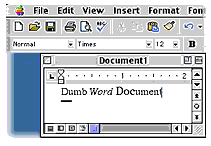|
|||||||||
Writing Web Pages
Ok, so how do we write Web pages? Let's think of some analogous
cases
| To work with | We use a | |||
| Formatted text Tabular numerical data Images Presentation Web Page |
Word Processor Spreadsheet Image Editor Presentation Program ? |
|||
 Let's think for a moment what these do. Part of a Microsoft
Word document is shown to the left. Some of the text is italic,
some is bold, and we've changed the size of the font. There's a
"Format" menu that lets us change the formatting (indent, etc.) of
paragraphs, and we can insert things like bulleted (which sounds too
violent, doesn't it? Let's call them "emphasis dotted") lists, etc.
How does the word processor do this? It inserts little clues in
the document so that it knows how to display it.
Let's think for a moment what these do. Part of a Microsoft
Word document is shown to the left. Some of the text is italic,
some is bold, and we've changed the size of the font. There's a
"Format" menu that lets us change the formatting (indent, etc.) of
paragraphs, and we can insert things like bulleted (which sounds too
violent, doesn't it? Let's call them "emphasis dotted") lists, etc.
How does the word processor do this? It inserts little clues in
the document so that it knows how to display it.
How is editing a Web document different? In many senses, it isn't -- we can use an editor to write the page and insert all of the clues that tell how to display it. The clues telling how to display a Web page are called HyperText Markup Language (HTML). The thing that makes HTML documents different from, say, Word are that (1) HTML was developed by, and must be readable by many different people with different browsers on many different platforms, and (2) at its heart, HTML is a content-description, not formatting, language.
Note that (1) is different from, say, a Word document -- which is only read by Microsoft Word, and (2) means that HTML wasn't designed to produce heavily formatted documents. Not that we are stopped from doing this. HTML is also pretty simple.
A Simple Example
Let's consider three views of an HTML file: the actual HTML markup,
how it displays, and what it looks like in a Web editor (for this
example we show Adobe PageMill).
|
|||||||||
What do you think? That doesn't look too hard, does it? We'll use DreamWeaver as our Web editor for our workshop, which has a bunch of useful features which make maintaining a Website pretty easy!
(of course, I actually use emacs to do my Web pages...)
|